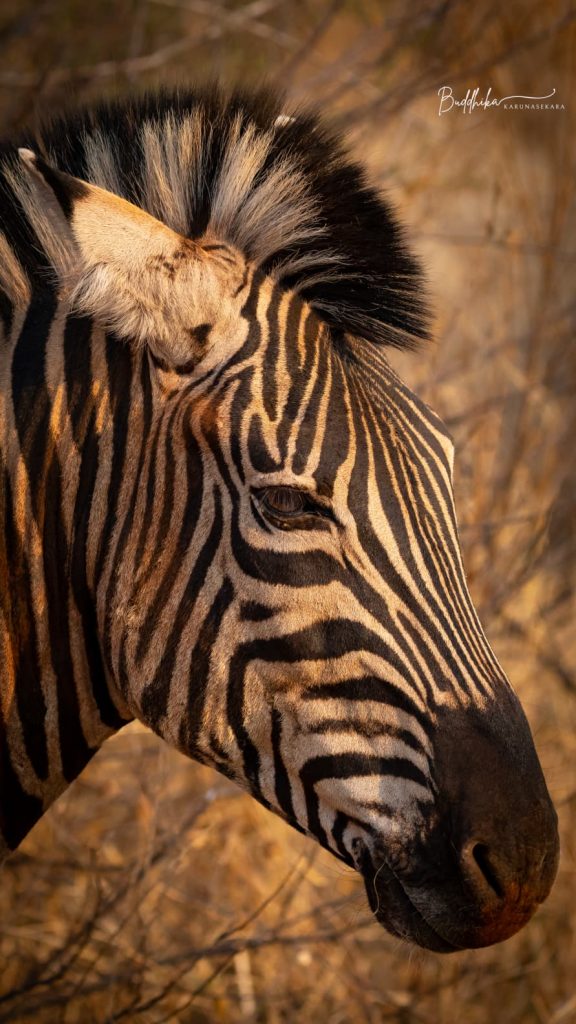
Striking and elusive, the zebra is one of the most recognisable creatures of the African plains. Its bold black and white stripes have fascinated people for centuries, sparking myths and debates about whether the animal is black with white stripes or white with black. Living in herds across savannahs and grasslands, zebras are highly social, relying on group cohesion and alertness to survive predators. Their calls, which range from barking to braying, and their distinctive stripe patterns, unique to each individual, have made them enduring symbols of identity and unity.
In African traditions, the zebra is often seen as a creature of duality and balance. Among the San people of southern Africa, tales describe the zebra’s stripes as the result of a fire, with an angry baboon throwing burning sticks at a once plain-coloured horse. The flames scorched its hide into stripes, leaving the zebra forever marked by conflict and transformation. Such stories highlight the zebra as a symbol of survival, carrying scars that turn into beauty.
In Zulu folklore, the zebra is admired for its cooperation and watchfulness. Proverbs speak of the herd that thrives together, drawing lessons about community and shared strength. The stripes, blending black and white, are sometimes invoked as metaphors for harmony between differences, teaching that unity can be found in diversity. Similarly, in Shona culture of Zimbabwe, the zebra appears in stories as a mediator, standing between worlds of light and dark, embodying balance and reconciliation.
Other communities also tell stories of the zebra’s origins. In Kenya, a tale recounts how a zebra walked through the fire of a quarrelsome baboon and emerged with burn marks that became stripes, a reminder of conflict and resilience. In South African folklore, the story of the Zebra Stallion tells of a young male defending his herd’s right to water against baboons, reflecting themes of courage, protection, and duty to family. In Botswana, the zebra has taken on a broader national symbolism. Its stripes, black and white side by side, are seen as emblems of equality and harmony, appearing proudly on the country’s flag and coat of arms as reminders of unity in diversity.
Beyond southern Africa, the zebra’s striking appearance has inspired curiosity and allegory. In East African folktales, it is sometimes portrayed as a stubborn animal, reluctant to be tamed, reflecting its real-life resistance to domestication. To pastoralist communities, the zebra’s refusal to serve humans becomes a reminder of freedom, a spirit that chooses the wild over submission. This independence has lent the zebra a place as a trickster figure in some tales, clever enough to avoid capture and bold enough to challenge expectations.
Colonial encounters added new layers of symbolism. To European settlers, the zebra’s stripes seemed exotic and baffling, and naturalists wove stories of camouflage and mystery. Victorian bestiaries described the zebra as a “painted horse of Africa”, casting it as a curiosity of nature’s imagination. In heraldry and art, the zebra later became an emblem of African identity, its pattern representing both wilderness and the unknown.
Modern conservation stories continue the zebra’s folkloric role as a symbol of resilience. In Kenya and Namibia, conservation groups use the zebra’s image to promote unity across communities, reminding people that just as no two zebras share the same stripes, each community brings unique value to shared survival. Ecotourism often highlights zebras as markers of healthy grasslands, their herds seen as a barometer of balance in the ecosystem.
Folklore also carries cautionary tones. Stories warn that a zebra’s beauty can attract envy, teaching that striking appearances must be matched with vigilance. At the same time, children’s tales present the zebra as playful and spirited, turning its unusual coat into a mark of joy and wonder. These shifting images reflect how the zebra straddles many meanings, never quite pinned down, always a creature of contrasts.
Today, zebras remain vulnerable to habitat loss, hunting, and conflict with human expansion. Yet their presence in stories ensures they are never forgotten. Around fires and in classrooms, the tale of how the zebra got its stripes continues to be told, a myth that ties people to land and animal.
To see a herd of zebras moving across the savannah is to witness a living tapestry, each stripe pattern a story, each herd a lesson in community. The zebra reminds us that difference can be strength, that beauty can carry hardship, and that the wild holds truths that endure beyond human imagination.
